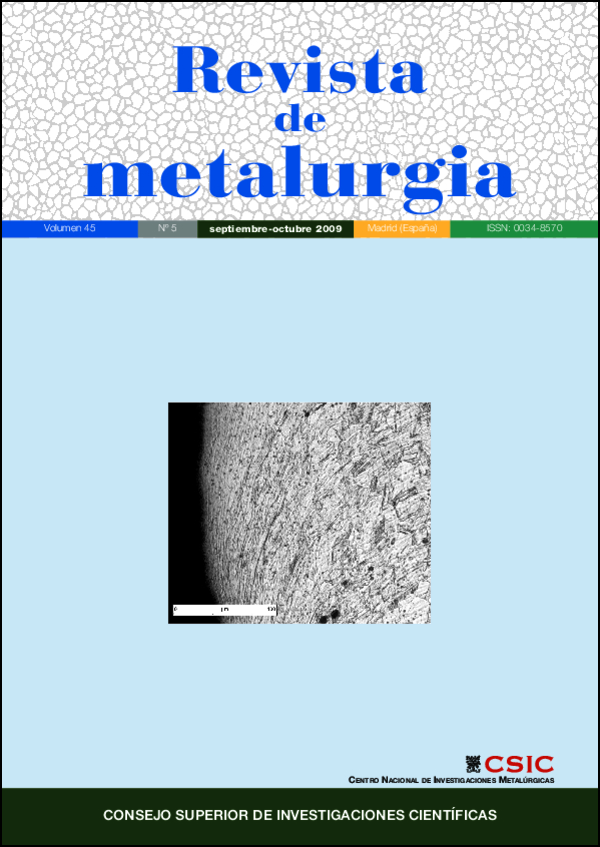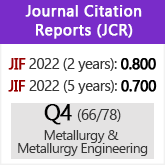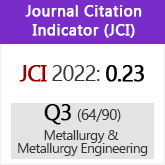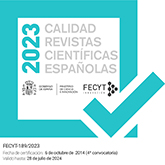Effect of the milling time on thermal stability of mechanically alloyed Mg50Ni50 amorphous alloy
DOI:
https://doi.org/10.3989/revmetalm.0853Keywords:
Amorphous, Mechanical alloying, Thermal stability, Hydrogen storage materials, X-ray diffractionAbstract
In order to study the relationship between the milling time used in the production of Mg50Ni50 amorphous alloy and its thermal stability, seven amorphous alloys were produced by milling for 20, 25, 30, 35, 40, 50 and 60 h each sample. The obtained powders were morphological and structurally characterized by scanning electron microscopy (SEM), Xray diffraction (XRD) and transmission electron microscopy (TEM), respectively. The thermal stability of amorphous alloys was study by differential scanning calorimetry (DSC). Based on the obtained results, it can be concluded that the increase in the added energy when milling for longer time causes the homogenization of the microstructure with an increase in amorphous phase, which dissolves a larger amount of nickel in its structure. Therefore, the simultaneous crystallization of the Mg2Ni and MgNi2 intermetallic compounds at 345 °C can be explained.
Downloads
References
[1] J. Reilly y R. Wiswall, Inorg. Chem. 7 (1968) 2.254-2.246.
[2] J. Benjamin, Metall. Trans. 1 (1970) 2.943- 2.951.
[3] J. Benjamin y T. Volin, Metall. Trans. 5 (1974) 1.929-1.934.
[4] P. Rojas, Tesis Doctoral, Facultad de Ingeniería, Universidad de Santiago de Chile, 2003.
[5] P. Rojas, S. Ordoñez, D. Serafíni, A. Zúñiga y E. La vernia, J. Alloy. Compd. 391 (2005) 267- 276. doi:10.1016/j.jallcom.2004.08.081
[6] S. Ordóñez, P. Rojas, D. Serafini y A. San Martín, J. Mater. Sci. Lett. 22 (2003) 717-720. doi:10.1023/A:1023719018545
[7] S. Orimo, H. Fujii, K. Ikeda, Y. Fujikawa y Y. Ki - ta no, J. Alloy. Compd. 253-254 (1997) 94-97. doi:10.1016/S0925-8388(96)02995-7
[8] L. Zaluski, A. Zaluska y J. Ström-Olsen, J. Alloy. Compd. 217 (1995) 245-249.
[9] C. Iwakura, S. Nora, S. Zhang y H. Inoue, J. Alloy. Compd. 285 (1999) 246-249.
[10] S. Orimo y H. Fujii, Appl. Phys. A. 72 (2001) 167-186. doi:10.1007/s003390100771
[11] D. Guzmán, S. Ordoñez, D. Serafini, P. Rojas y O. Bustos, J. Alloy. Compd. 471 (2008) 435- 441.
[12] S. Rouggeri, C. Lenain, L. Roue, G. Liang, J. Huot y R. Schulz, J. Alloy. Compd. 339 (2002) 195-201.
[13] N. Aydinbeyli, O. Celik H. Gasan y K. Aybar, Int. J. Hydrogen Energ. 31 (2006) 2.266-2.273.
[14] M. Abdellaoui y E. Gaffet, Acta Metall. Mater. 43 (1995) 1.087-1.098.
[15] C. Suryanarayana, Prog. Mater. Sci. 46 (2001) 1-184. doi:10.1016/S0079-6425(99)00010-9
[16] H. Kissinger, Anal. Chem. 29 (1957) 1.702-1.706.
[17] W. Liu, H. Wu, Y. Lei, Q. Wang y J. Wu, J. Alloy. Compd. 252 (1997) 234-237.
[18] S. Zhang, Y. Hara, T. Morikawa, H. Inoue y C. Iwakura, J. Alloy. Compd. 293-295 (1999) 552-555.
[19] S. Ji, J. Sun, Z. Yu, Z. Hei y L. Yan, Int. J. Hydrogen Energy 24 (1999) 59-63. doi:10.1016/S0360-3199(98)00039-1
Downloads
Published
How to Cite
Issue
Section
License
Copyright (c) 2009 Consejo Superior de Investigaciones Científicas (CSIC)

This work is licensed under a Creative Commons Attribution 4.0 International License.
© CSIC. Manuscripts published in both the printed and online versions of this Journal are the property of Consejo Superior de Investigaciones Científicas, and quoting this source is a requirement for any partial or full reproduction.All contents of this electronic edition, except where otherwise noted, are distributed under a “Creative Commons Attribution 4.0 International” (CC BY 4.0) License. You may read here the basic information and the legal text of the license. The indication of the CC BY 4.0 License must be expressly stated in this way when necessary.
Self-archiving in repositories, personal webpages or similar, of any version other than the published by the Editor, is not allowed.


















